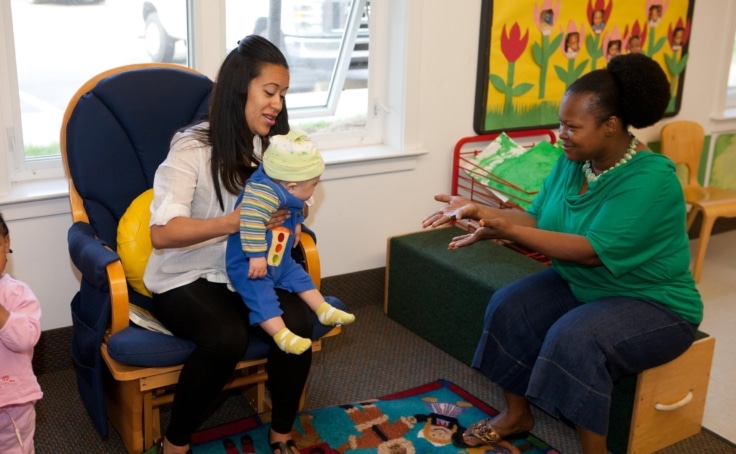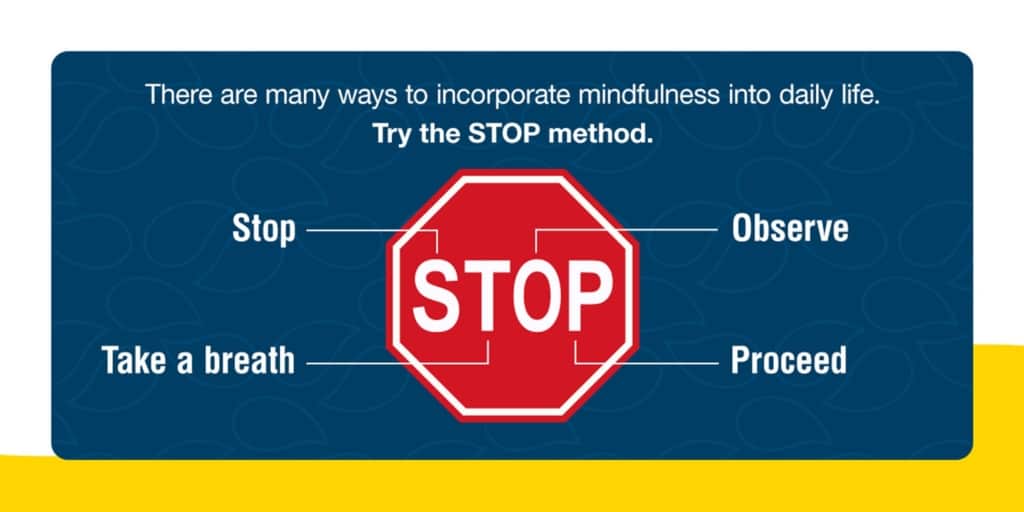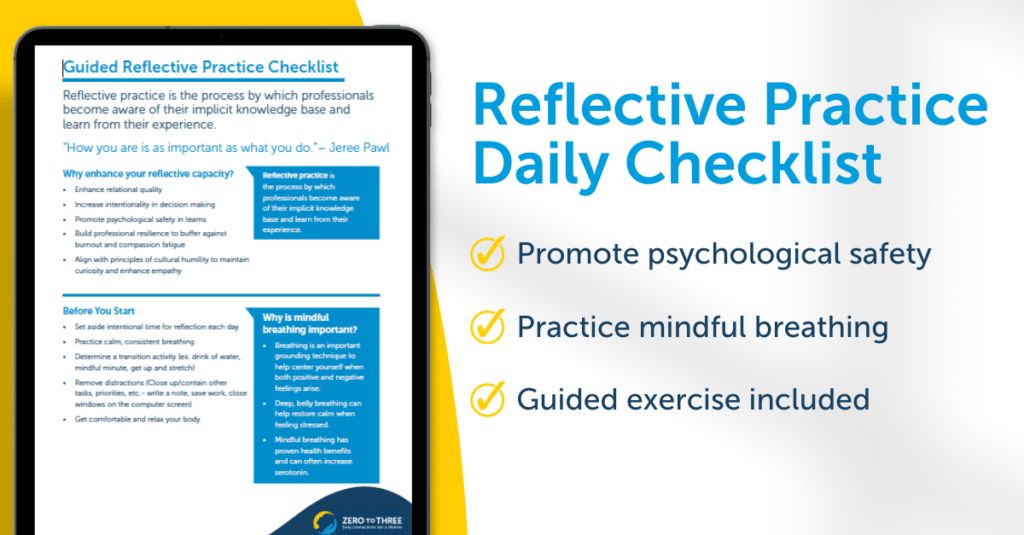Home/Resources/Child Care/Preventing Burnout in Early Childhood Professionals: Practical Self-Care Strategies
Preventing Burnout in Early Childhood Professionals: Practical Self-Care Strategies

Understanding the common causes and exploring ways to address burnout in early childhood education can help you effectively manage or even prevent it..
Burnout in early childhood education and service is more than simple fatigue; it's a state of mental, physical, and emotional exhaustion often experienced as a response to intense or prolonged stress.
The phenomenon may disguise itself as cynicism, detachment, and even feelings of helplessness or ineffectiveness.
On the physical side, burnout may manifest as headaches, stomachaches, changes in appetite, and continuing to feel drained following adequate rest. Emotionally, burnout may present as compassion fatigue, which is the absorption of a child’s or family’s pain.
Common causes of burnout
There are three main contributors to burnout in early childhood professionals: emotional labor, high workloads and lack of resources.
Emotional labor
Emotional labor is the effort required to manage emotions, especially when meeting workplace demands. It’s an active regulation of one’s own emotions to induce or prevent a specific emotional response in others. For example, a flight attendant stays calm during turbulence to appear reassuring. In early childhood education, emotional labor may look like patience with babies or toddlers, even when their behavior is challenging.
The more effort this management takes, the higher the emotional drain, and working with young children often comes with a significant one. Professionals must manage their emotions while simultaneously responding appropriately to the needs of young children and their families, sometimes in difficult or intense situations. Long days with an extensive emotional draw can lead to the following, which all contribute to feelings of burnout:
- Emotional exhaustion
- Reduced feelings of personal satisfaction and accomplishment
- Empathy strain
- Challenges in setting healthy boundaries
High workloads
Many industries experience staffing shortages, and early childhood services are no exception. The United States Bureau of Labor Statistics reported that the workforce in child care settings decreased by 5.9% between 2020 and 2023.
As a result, high workloads and increased stress are common. Professionals often find themselves in constant stress response mode as they juggle more demands. There’s also less downtime available to recharge during the day. Research has found that 36% of infant-toddler teachers have no designated daily break, and 34% have no space for relaxation.
Consistently spending mental and emotional energy can make professionals feel frazzled, exhausted, and powerless. This can lead to impaired work-life balance for teachers and clinicians and cause physical symptoms like sleep issues and headaches. The stress can also increase job dissatisfaction, sparking higher employee turnover and restarting the cycle.

Lack of resources
A lack of resources substantially contributes to burnout by causing more stress and frustration. Professionals may perceive failure as predetermined if they can’t fully meet the needs of those they serve. For example, limited access to specialized materials may make it challenging to support a child with developmental delays, disorders, or disabilities.
Teachers and clinicians may also experience feelings of guilt and inadequacy if they sense that they’re being forced to cut corners or compromise their quality of service. For instance, understaffing may result in less one-on-one time or shorter observations and interactions. Additionally, resource gaps can lead to a lack of professional development opportunities, further increasing job dissatisfaction and the potential to develop burnout.
How much to early childhood educators make?
Being an early childhood educator requires immense dedication and skill — and it’s time their compensation reflects that.
Self-care tips for early childhood educators and professionals
The increased propensity for burnout due to the factors above reinforces the fact that self-care is nonnegotiable.
Clinician and teacher burnout prevention strategies can help build a stronger arsenal of tools to cope with rising stress and frustration. This is vital, because mental health starts with you as a primary caregiver for babies and toddlers.
Mindfulness
Mindfulness is the intentional practice of being fully present in any given moment and approaching it with openness and acceptance.
Mindfulness offers many benefits in managing stress in childcare workers and professionals as well as the children and families they serve. These advantages include:
- Reduced anxiety: This exercise can help regulate the nervous system, promoting the projection of calmness and preventing the triggering of the child’s stress response.
- Higher empathy and compassion: This practice enables deeper connections with others, which enhances kindness, empathy, and compassion.
- Improved well-being: A recent study reported that participants engaging in mindfulness had a 19.2% larger reduction in depression and a 6.29% improvement in well-being versus the control group.

There are many ways to incorporate mindfulness into daily life. Try the STOP method — stop, take a breath, observe, and proceed. Other tactics to explore include breathing exercises and hand-to-heart meditation.
Download our free mindfulness toolkit for more practical tips.
Seeking peer support
Consider forming a peer support group or establishing individual mentorships to help with stress management in child care settings or clinical interactions.
Peers share similar values, understand each other’s challenges, and can validate emotions, reducing the feeling of isolation that burnout can create. Connecting also opens the discussion to different perspectives, possible solutions, and practical tips or advice based on experience. Plus, experienced peers can often spot the warning signs of burnout quickly and mobilize support resources before the issue worsens. All create a more positive work environment and support higher job satisfaction.
Setting boundaries
Establishing healthy boundaries prevents burnout by protecting professionals’ time and energy. Healthy boundaries also help:
- Prevent overextension or overcommitment.
- Reduce emotional exhaustion and stress.
- Reinforce self-worth and self-respect by promoting the prioritization of well-being.
- Protect enthusiasm for serving babies, toddlers, and their families.
Self-reflection is the ideal starting point for mental health support for educators and clinicians. It improves self-awareness and forces consideration of the reasons behind individual feelings and actions. Consider options like reflective journaling and peer reflection for deeper exploration. These reflective practice exercises allow professionals to acknowledge their challenges, identify areas they can control, and practice new responses.
Free Learning Module
Mindfulness for Early Childhood Educators
Access our learning module designed for early childhood educators and program directors interested in exploring mindfulness as a means of supporting staff and the children in their care.

Workplace policies for support
Supportive workplaces empower a culture that prioritizes well-being — reducing burnout and providing an environment where professionals can thrive.
Reflective supervision
Reflective supervision is a relationship-based approach to skills enhancement that supports capabilities to serve infants, young children, and their families. The technique involves regular reflection, collaboration, and analysis to build more effective working relationships between all parties.
During these exchanges, professionals can openly discuss their feelings, challenges, and experiences with their supervisors for feedback, advice, and support. Supervisors can also recognize potential symptoms of burnout and encourage well-being strategies. Incorporate this practice by being active in regular interactions and engaging in open, honest communication.

Our reflective practice daily checklist helps early childhood professionals set intention to make it part of their routine.
Ensure adequate time for breaks
Whenever possible, give staff regular opportunities to pause and recharge — even a few minutes away can make a meaningful difference in reducing burnout.
Many states require a 30-minute break for employees scheduled to work more than 5 or 6 consecutive hours. However, some child care centers, particularly family child care educators who usually work alone, may have exceptions or different requirements.
Professional development opportunities
Early childhood service is a dynamic field that continues evolving as research and knowledge expand. As a result, it’s critical for ECE professionals to stay up to date and improve their abilities.
Comprehensive professional development opportunities are the ideal solution for enhancing competencies and skills. Training also contributes to feelings of accomplishment and growth, boosting job satisfaction and keeping burnout at bay. There are many formats to accommodate differing learning styles, and researching available training opportunities helps ensure they meet unique needs for various skill levels.
Tell Congress to invest in child care and its workforce.
Read More

Next Up
Go to Next Resource
webinar
New Data on the Health and Well-Being of Early Childhood EducatorsExplore recent data on an array of factors showing the pandemic’s impact on early childhood educator well-being.
